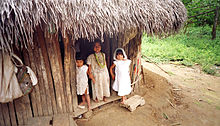Kogi
The Kogi people , also called Kággaba , live on the northern and eastern slopes of the Sierra Nevada de Santa Marta in Colombia . In the Resguardo Arhuaca of Guatapurí they share their land with the Sánha , Kankuama and Ika . Their language belongs to the Chibcha family . According to the Summer Institute of Linguistic, SIL, their number is estimated at 4,000–6,000.
history
The Sierra Nevada de Santa Marta and the neighboring lowlands have been inhabited for thousands of years. When the Spaniards arrived in the early 16th century, the region around Santa Marta (founded in 1526) and the northern foothills and slopes of the massif were inhabited by Tairona Indians.
In 1630 the Tairona were finally defeated by the Spanish troops. The survivors, along with survivors of other tribes, fled to the fortress-like mountains, while other regions were of greater interest to the Spanish colonists.
This population was known under the general name Arhuacos from the 17th century . In modern ethnographic literature, a distinction is made between three peoples: the Kogi, on the northern slopes of the valleys of the Río Palomino , Río San Miguel and Río San Francisco, the Ika on the southern slopes and the Sánha on the eastern slopes. The Kogi claim to be descended directly from the Tairona, a belief that is supported by some evidence. Today they are the least acculturated people.
literature
- Konrad Theodor Preuss : Research trip to the Kágaba: observations, text recordings and linguistic studies with an Indian tribe in Colombia, South America. Taken on behalf of the Berlin State Museums, with funds from the Duke of Loubat Professorship Foundation, ed. with the support of the Notgemeinschaft der deutschen Wissenschaft, 3 vols., Anthropos, St. Garbriel-Mödling near Vienna, 1926/27
Web links
- Literature about the Kogi in the catalog of the Ibero-American Institute in Berlin
- http://www.etniasdecolombia.org
- http://www.sil.org
- http://www.tchendukua.com/
- http://www.bis-ans-ende-der-welt.net/Kol-2001.htm Report and pictures about a hike through the Sierra Nevada de Santa Marta with contacts to Kogi Indians
This article is based on the article Kogi ( Memento from July 1, 2010 in the Internet Archive ) from the free encyclopedia Indianer Wiki ( Memento from March 18, 2010 in the Internet Archive ) and is under Creative Commons by-sa 3.0 . A list of the authors was available in the Indian Wiki ( Memento from July 1, 2007 in the Internet Archive ).

